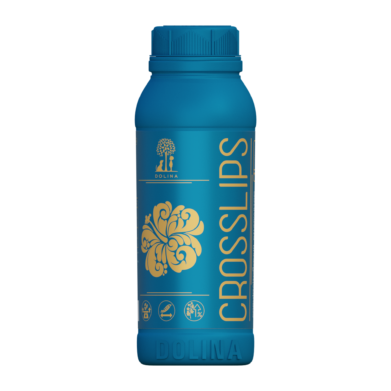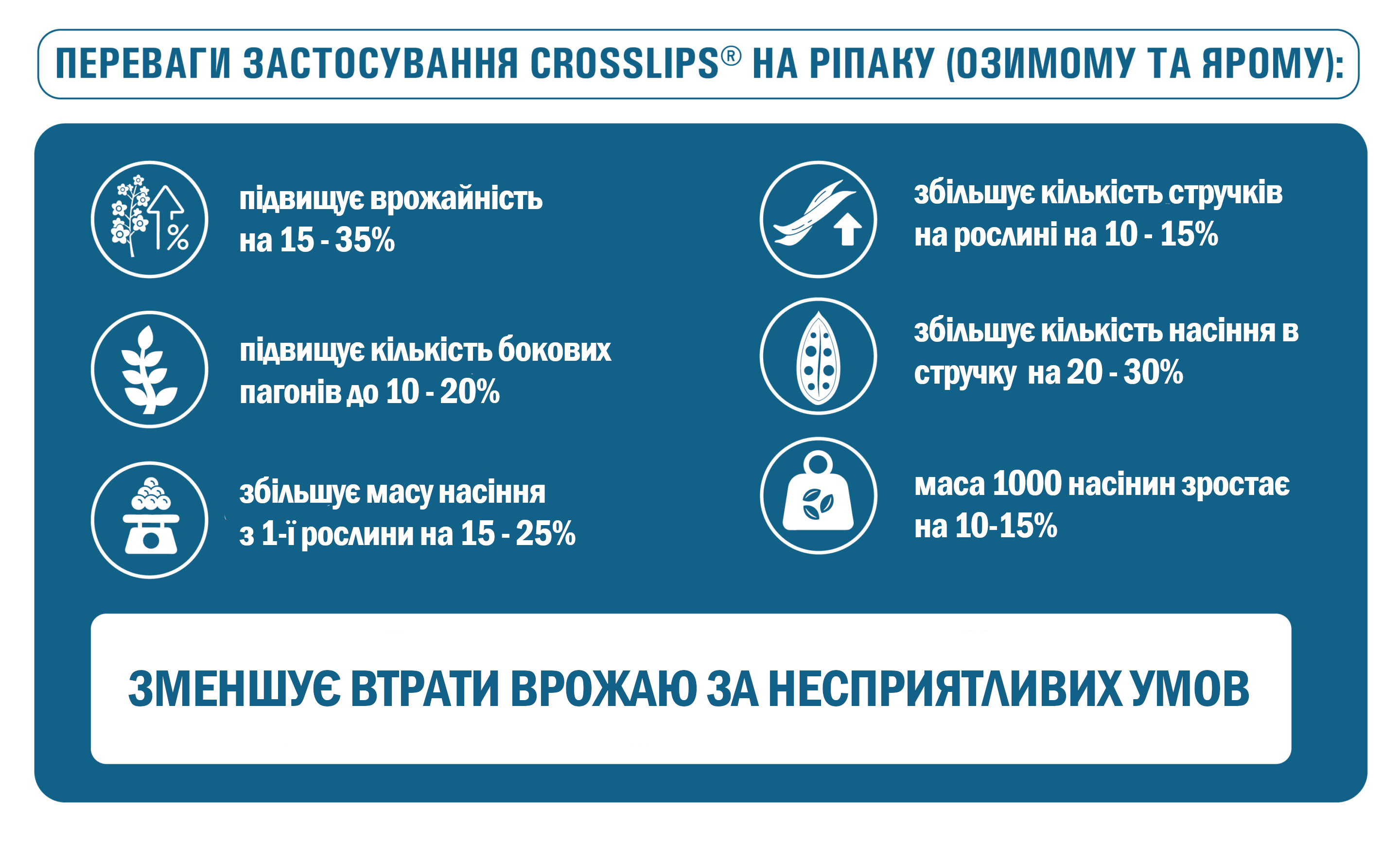Rapeseed growth stimulant CROSSLIPS
Rapeseed is a light- and moisture-loving plant of a temperate climate. Like every other crop, it has its own needs for optimal values and biological minimums of the main agrometeorological variables: heat, moisture and solar radiation. The highest yield is formed when the needs of plants and optimal values of environmental factors are fully met, meteorological variables constituting a large proportion of it.
Deficiency of nutrients and environmental stress factors lead to the loss of some of the productivity elements which the plant cannot “feed”. For winter rapeseed, the period from the germination of plants to their entry into winter is extremely important. Very often at this time there is little moisture in the upper soil layer, and therefore the growth and development of the root system and the plant as a whole is inhibited.
Studying the peculiarities of rapeseed plant growth and development, scientific department specialists of the DOLINA company created a specialized rapeseed growth stimulator CROSSLIPS®, which contains synthetic analogues of natural growth regulators.
These substances are formed during metabolic processes and are required in miniscule quantities to start and regulate physiological and genetic programs of plants. Plant growth regulators are formed in certain plant tissues and transported to other organs and tissues, influencing such basic physiological processes as growth, development, fruit formation and adaptation to environmental factors.
A characteristic feature of regulators, which distinguishes them from other physiologically active substances (vitamins, trace elements), is that they switch physiological and genetic programs. According to the modern classification, these are the biological regulators of plant growth and development, which control the processes of interaction of cells, tissues and organs, stimulating and inhibiting genetic and physiological processes in plant organisms.
The active components of the CROSSLIPS® stimulator act specifically on cells competent for these substances, i.e. cells in the membranes and cytoplasm of which specific receptors are present.
The interaction of the substance with its receptor triggers a chain of reactions that transform the signal into functional responses of the cell.
In addition, due to the above effects, the active ingredients of the CROSSLIPS® stimulator neutralize the effect of abscisic acid. The abscisic acid is found in all organs and tissues of the plant and can be synthesized in many of them: leaves, roots, seeds.
Abscisic acid inhibits growth and metabolic processes, inhibits moisture transpiration in drought conditions, and activates the fall of flowers and fruits of many plants.
Lack of moisture leads to a sharp activation of the synthesis of this phytohormone and its release from the sites of deposition into the intra- and extracellular space. In cells, the acid causes a rapid release of potassium, causing decrease of these cells turgor and the closing of stomata.
The components of CROSSLIPS® are antagonists of abscisic acid, which allows to reduce its effect on the plant organism and increase the intensity of the cultivation technology.
If you have any questions about purchasing, consulting, and terms of cooperation, please contact:
+38 050 474 21 42
+38 067 642 12 24
APPLICATION RATE
| Crop | Period | Rate |
|---|---|---|
| Winter and spring rapeseed | Inflorescence emergence – beginning of flowering (most effectively ВВСН 55 – 59) | 50 mL/ha |
Frequently asked questions about the application of the CROSSLIPS formulation on rapeseed
Can the application of the CROSSLIPS formulation affect negatively the flowering of rapeseed?
Answer: the application of the CROSSLIPS formulation in recommended doses cannot cause phytotoxicity and damage to the generative organs of plants, since:
- the formulation was being tested for several years during the flowering period with application rate up to 300 mL/ha inclusive;
- the formulation has a systemic, not a contact effect, therefore in any case it enters the growth points regardless of the place of contact with the plant.
Is it possible to add the CROSSLIPS formulation and Orakul Colofermine of Boron to the tank mixture during the flowering period of rapeseed?
Answer: our tests showed a synergistic effect of combining these products in the tank mixture. The application of ORAKUL COLOFERMINE OF BORON (rate 0.7 L/ha) provided an enhanced effect, namely an additional increase in yield of 240 – 280 kg/ha.
Is there a risk of pollen sticking and a decrease in pollination when applying the growth stimulant “VIMPEL 2” on rapeseed during the flowering period?
Answer: we have not studied this issue. However, applying the formulations CROSSLIPS and VIMPEL 2 in one tank mixture; CROSSLIPS, VIMPEL 2 and ORAKUL COLOFERMINE OF BORON are very effective if they are used in the budding phase of rapeseed.
The following combinations of formulations used in the tank mixture (bud formation phase) showed good results in the ascending ordering:
- CROSSLIPS 50 mL/ha + 0.7 L/ha ORAKUL COLOFERMINE OF BORON;
- CROSSLIPS 100 mL/ha + 0.7 L/ha ORAKUL COLOFERMINE OF BORON;
- CROSSLIPS 50 mL/ha + 0.7 L/ha ORAKUL COLOFERMINE OF BORON + 0.5 L/ha “VIMPEL 2”.
In addition, high efficiency was shown by treating rapeseed with a tank mixture of the formulations CROSSLIPS 100 mL/ha + adjuvant AD’YUTANT 0.3 L/ha during the bud formation and beginning of flowering phase.
For how long have the tests of the formulation been conducted and where?
Answer: The CROSSLIPS formulation has been used in the fields of research institutions of Ukraine for 5 years. The studies were conducted in different regions of the country, under different natural and climatic conditions on rapeseed crops.

